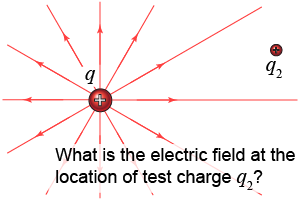|
The electric field is a vector field that defines the strength and direction of the electric force in space. The magnitude of the electric field is given by equation (18.2). The units of electric field are newtons per coulomb (N/C). For example, if the electric field strength at a certain point in space equals 1 N/C, this means a 1 C charge placed at this point would feel a 1 N force. A 0.5 C charge would feel a 0.5 N force. 
|
The force of gravity near the Earth’s surface is Fg = mg, whereas the electric force on a charged body is Fe = qE. The acceleration of gravity, g, can be viewed as a field in a similar way to the electric field E. The units of g are N/kg and the units of electric field E are N/C. 
|
We introduced the volt as a unit of electrical potential energy on page 475. We can now extend our earlier definition. A charge of 1 C gains 1 J of energy when it moves across 1 V of potential difference, so 1 V is 1 J/C. 
| 
|
The volt provides a much more practical way to define the electric field. One newton per coulomb is the same as one volt per meter. Consider the electric field between two parallel plates. If the plates are separated by 1 cm (0.01 m) and connected to a 1.5 volt battery, the electric field between them is 150 V/m. A 1 C charge placed between the plates feels a force of 150 N because 150 V/m = 150 N/C. 
|
 How can we calculate the electric field at a location near a point charge q? Assume we have a small, imaginary “test charge” q2 located a distance r away. Dividing Coulomb’s law by q2 gives the field of a point charge (equation 18.3): The value of the test charge q2 cancels out of the equation for electric field—which it should, because this is a test charge!
How can we calculate the electric field at a location near a point charge q? Assume we have a small, imaginary “test charge” q2 located a distance r away. Dividing Coulomb’s law by q2 gives the field of a point charge (equation 18.3): The value of the test charge q2 cancels out of the equation for electric field—which it should, because this is a test charge! 
|
| (18.3) | | | E | = | electric field (N/C) | | ke | = | Coulomb constant = 9.0×109 N m2/C2 | | q | = | electric charge (C) | | r | = | distance between the two objects (m) |
| Electric field
for a point source |
|
Do you see the similarity between the electric field of a point charge in equation (18.3) and the electric force between two point charges in Coulomb’s law (equation 18.1)? You simply multiply the electric field by charge q2 to determine the electric force. Electric field is the electric force per unit charge, as you can also see in equation (18.2). The electric field of a point charge falls off as 1/r2, in the same way that the Coulomb force falls off with the distance squared. 
|

